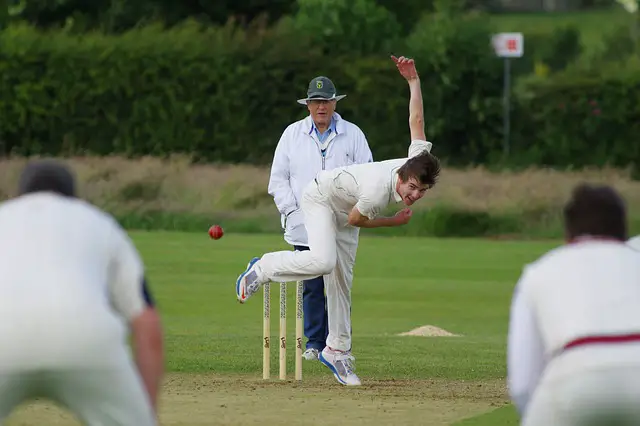The Difference Between Chucking and Bowling in Cricket
In cricket, “bowling” refers to the act of delivering the ball to the batsman, while “chucking” refers to an illegal action in which the bowler’s arm bends more than the allowed 15 degrees while delivering the ball. Chucking is prohibited in cricket as it can give the bowler an unfair advantage by making it difficult for the batsman to predict the trajectory of the ball. A bowler who is found to be chucking can be called for a no-ball, which results in a free delivery to the batsman.
What is chucking in cricket?
In cricket, “chucking” refers to an illegal action in which a bowler’s arm bends more than the allowed 15 degrees while delivering the ball. This is prohibited as it can give the bowler an unfair advantage by making it difficult for the batsman to predict the trajectory of the ball. A bowler who is found to be chucking can be called for a no-ball, which results in a free delivery to the batsman and also the bowler is not allowed to bowl again in that innings. Umpires are responsible for monitoring the bowler’s action and calling a no-ball if they suspect chucking is taking place.
How do you bowl without chucking?
(Image by Lisa scott from Pixabay )

To bowl without chucking in cricket, a bowler should ensure that their arm does not bend more than 15 degrees while delivering the ball. This can be achieved by maintaining a straight arm, and keeping the elbow and wrist in line throughout the bowling action.
There are a few techniques that can help a bowler bowl without chucking:
- Keeping the elbow and wrist in line: This helps to maintain a straight arm and prevent excessive bending.
- Using the shoulder and upper body: The majority of the force in the delivery should come from the upper body, not the arm.
- Practicing the correct technique: Regular practice with a coach or experienced player can help a bowler develop the correct technique and muscle memory.
- Being aware of the umpires: Bowlers should be aware of the umpires and their position on the field, to be able to detect early if they are close to chucking.
It’s important to note that the laws of cricket do allow for some natural flexion in the elbow joint, so the 15-degree limit is not an exact measurement and is judged by the umpire.
Why is chucking not allowed in cricket?
Chuckling is not allowed in cricket because it gives the bowler an unfair advantage by making it difficult for the batsman to predict the trajectory of the ball. When a bowler throws the ball instead of bowling it, the ball can move in an unpredictable way, making it harder for the batsman to hit. This can lead to more wickets, and make it more difficult for the batting team to score runs.
Also, chucking puts extra stress on the elbow and shoulder of the bowler, which can lead to injuries over time.
Allowing chucking in the game would compromise the fairness and integrity of the game, and also would be unsafe for the players. That’s why the International Cricket Council (ICC) has put in place laws to prevent chucking, and umpires are responsible for monitoring the bowler’s action and calling a no-ball if they suspect chucking is taking place.
How do you know if the bowler is chucking?
In cricket, a bowler is considered to be chucking if their arm bends more than the allowed 15 degrees while delivering the ball. Umpires are responsible for monitoring the bowler’s action and calling a no-ball if they suspect chucking is taking place.
To determine if a bowler is chucking, umpires will typically look for several key indicators, such as:
- Excessive bending of the arm: If the bowler’s arm is bending more than 15 degrees, it is considered chucking.
- Straightening of the arm: Umpires will look for a bowler who straightens their arm after releasing the ball, which can indicate that the arm was bent during the delivery.
- Elbow extension: Umpires will look for a bowler who extends their elbow during the delivery, as this can indicate that the arm is bending excessively.
- Wrist position: Umpires will also look at the position of the bowler’s wrist, as an unusual or exaggerated wrist position can indicate chucking.
- Slow motion replays: Umpires can also use the slow motion replays to detect any illegal actions, in case of doubt.
It’s important to note that the laws of cricket do allow for some natural flexion in the elbow joint, so the 15-degree limit is not an exact measurement and is judged by the umpire.
What is the rule for chucking in cricket?
The rule for chucking in cricket is laid out in Law 24 of the International Cricket Council’s (ICC) Laws of Cricket. According to the law, a bowler’s arm must not straighten (i.e. extend) at the elbow during the delivery swing. The umpire at the bowler’s end shall judge this.
The ICC also allows some degree of natural flexion in the elbow joint, defined as 15 degrees, which is measured by the angle between the upper arm and the forearm when the arm is extended. This rule applies to all deliveries, including fast, medium and slow pace, spin, and wrist spin.
A bowler who is found to be chucking will be called for a no-ball. A no-ball results in a free delivery to the batsman and also the bowler is not allowed to bowl again in that innings. If a bowler repeatedly bowls no-balls for throwing, the umpire will report the bowler to the cricket board for a suspected illegal action.
It’s important to note that the ICC also has a process to test and analyse the bowler’s action, if they are reported for suspected illegal action. The bowler can also be suspended from bowling until they have remodeled their action and passed the test.
What are some bowling etiquettes?
- Respect the umpire’s decisions: Bowlers should respect the decisions of the umpire and not argue or show dissent, as this can lead to penalties and disciplinary action.
- Observe safety precautions: Bowlers should always observe safety precautions and not aim at the batsman’s head or body. They should also ensure that their follow-through does not put other players at risk.
- Be aware of the field: Bowlers should be aware of the field and the positions of the fielders, and should not deliberately bowl to an unguarded area of the field.
- Be aware of the game situation: Bowlers should be aware of the game situation and the number of wickets remaining, and should not waste deliveries when the team is close to victory.
- Show sportsmanship: Bowlers should show sportsmanship and respect for the opposing team, and should not engage in unsportsmanlike conduct such as sledging or taunting.
- Maintain the ball: Bowlers should keep the ball clean and dry, and should not tamper with the ball in any way.
- Observe time limit: Bowlers should be aware of the time limit and should not deliberately slow down the game by taking too long between deliveries.
Who are some of the quickest bowlers in cricket history?
There have been many fast bowlers throughout the history of cricket, but some of the quickest bowlers are:
- Jeff Thomson: He was an Australian cricketer of the 1970s, known for his ferocious pace and intimidating bouncers. He is considered one of the fastest bowlers of all time.
- Shoaib Akhtar: He is a former Pakistani cricketer, known for his express pace. He holds the record for the fastest delivery ever recorded in international cricket, at 161.3 km/h (100.23 mph).
- Brett Lee: He was an Australian cricketer, who was known for his ability to bowl at high speeds and his aggressive style of play. He consistently bowled at around 155km/h (96.3 mph)
- Allan Donald: He was a South African cricketer, who was known for his ability to bowl at high speeds and his aggressive style of play. He consistently bowled at around 145km/h (90.1 mph)
- Michael Holding: He was a Jamaican cricketer, who was known for his ability to bowl at high speeds and his smooth and fluent action. He consistently bowled at around 145km/h (90.1 mph)
- Dale Steyn : He was a South African cricketer, who was known for his ability to bowl at high speeds and his aggressive style of play. He consistently bowled at around 145km/h (90.1 mph)
- Mitchell Starc: He is an Australian cricketer, who is known for his ability to bowl at high speeds and his aggressive style of play. He consistently bowls at around 145km/h (90.1 mph)
- Glen McGrath: He was an Australian cricketer, who was known for his ability to bowl at high speeds and his ability to swing the ball both ways. He consistently bowled at around 145km/h (90.1 mph)
These are just a few examples, as there have been many fast bowlers throughout the history of cricket, but these are considered among the quickest of all time.
Can leg spinners chuck?
Leg spinners, like all other bowlers, are subject to the same rules regarding chucking in cricket. According to the rules laid out in Law 24 of the International Cricket Council’s (ICC) Laws of Cricket, a bowler’s arm must not straighten (i.e. extend) at the elbow during the delivery swing. The umpire at the bowler’s end shall judge this. The ICC also allows some degree of natural flexion in the elbow joint, defined as 15 degrees, which is measured by the angle between the upper arm and the forearm when the arm is extended.
Leg spinners use a different technique for delivering the ball as compared to other bowlers, which typically involves a leg spinner spinning the ball with the fingers, causing it to spin on a vertical axis. Leg spinners may also use a flicking action of the wrist to impart spin to the ball. So, it is possible for a leg spinner to bowl with an illegal action if their arm extends more than the allowed 15 degrees, this will be considered as chucking.
It’s important to note that the ICC also has a process to test and analyse the bowler’s action, if they are reported for suspected illegal action. The bowler can also be suspended from bowling until they have remodeled their action and passed the test.
What are the types of fast bowlers in cricket?
In cricket, there are several types of fast bowlers, each with their own unique style of bowling and approach. Some of the most common types of fast bowlers include:
- Seamers: These bowlers rely on swinging the ball through the air, and are known for their ability to move the ball both ways. They use the seam of the ball to make it swing, by holding the ball with the seam in a vertical position and releasing it with a slight rotation of the fingers.
- Swing bowlers: Similar to seamers, these bowlers rely on swinging the ball through the air. They are known for their ability to move the ball both ways, but they achieve this by using a different technique than the seamers, which is by using the air pressure on the ball with different angle of release.
- Fast-medium bowlers: These bowlers deliver the ball at a moderate pace and rely on line and length to take wickets. They are known for their ability to hit the top of off stump and the stumps in general.
- Express bowlers: These bowlers deliver the ball at the highest speed and rely on raw pace to take wickets. They are known for their ability to bowl bouncers and intimidate the batsman.
- Cutters: These bowlers rely on their ability to make the ball cut or move off the pitch, by using a different grip or releasing the ball with a different angle than usual. They are known for their ability to make the ball move late and take wickets.
- Reverse-swing bowlers: These bowlers rely on their ability to make the ball swing in the opposite direction of the usual swing, by using a different grip or releasing the ball with a different angle than usual. They are known for their ability to make the ball move late and take wickets.
What are the types of spin bowlers in cricket?
- Off-spinners: These bowlers rely on their ability to make the ball spin away from the right-handed batsman, by using a different grip or releasing the ball with a different angle than usual. They use their fingers to impart spin on the ball, and are known for their ability to take wickets by making the ball turn and bounce off the pitch.
- Leg-spinners: These bowlers rely on their ability to make the ball spin towards the right-handed batsman, by using a different grip or releasing the ball with a different angle than usual. They use their fingers to impart spin on the ball, and are known for their ability to take wickets by making the ball turn and bounce off the pitch.
- Left-arm orthodox spinners: These bowlers rely on their ability to make the ball spin away from the left-handed batsman, by using a different grip or releasing the ball with a different angle than usual. They use their fingers to impart spin on the ball, and are known for their ability to take wickets by making the ball turn and bounce off the pitch.
- Left-arm unorthodox spinners : These bowlers rely on their ability to make the ball spin away from the left-handed batsman, by using a different grip or releasing the ball with a different angle than usual. They use their fingers to impart spin on the ball, and are known for their ability to take wickets by making the ball turn and bounce off the pitch, They are also known for their ability to bowl deliveries that are difficult for the batsman to pick, like the chinaman and flipper.
- Slow left-arm orthodox spinners: These bowlers rely on their ability to make the ball spin away from the left-handed batsman, by using a different grip or releasing the ball with a different angle than usual. They use their fingers to impart spin on the ball, and are known for their ability to take wickets by making the ball turn and bounce off the pitch. They deliver the ball at a slow pace.
- Slow left-arm unorthodox spinners: These bowlers rely on their ability to make the ball spin away from the left-handed batsman, by using a different grip or releasing the ball with a different angle than usual. They use their fingers to impart spin on the ball, and are known for their ability to take wickets by making the ball turn and bounce off the pitch. They also use different deliveries like the chinaman and flipper and deliver the ball at a slow pace.
Featured Image By – Image by Lisa scott from Pixabay









